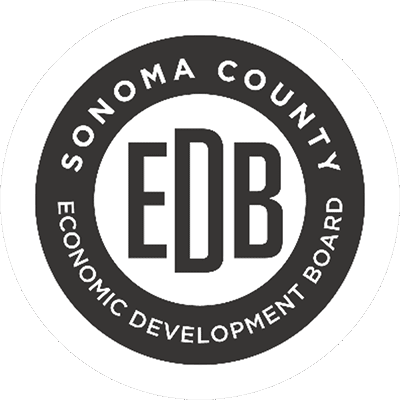Goal: Be a leader in environmentally-sustainable practices


About 50% of Strategic Sonoma Sustainability Goals are completed or ongoing.
Measure of Success
- Water Quality
- Greenhouse Gas Emissions
- Electric Vehicle Adoption
- Renewable Energy Adoption
- Open-Space Preservation
- Environmental-Business Employment
Collective Impact Partners
- Sonoma County Regional Climate Protection Authority
- Sonoma County Water Agency
- Sonoma Clean Power
- Pacific Gas & Electric
- Sonoma County Climate Action
- Local Cities
- Local Chambers of Commerce and Trade Organizations
- Sustainable North Bay
- Environmental Non-Profits
Russian River Watershed Association Public & Private California Research
Universities
Private Employers
Sustainable Enterprise Conference
Objective: Sonoma County is a global leader in addressing climate change and a recognized center or sustainable practices and businesses.
 The natural environment is Sonoma County’s greatest asset. The fertile landscape has long made it an agricultural center. Residents and businesses consistently cite the climate and outdoor lifestyle as primary reasons for living and working in Sonoma County, and they have put environmental protection at the core of Sonoma County’s cultural identity. For many years, Sonoma County has explored new ways of addressing climate change and being more sustainable through the work of public agencies like the Sonoma County Regional Climate Protection Authority, Sonoma Clean Power, Sonoma County Water Agency, and private organizations like Sonoma County Climate Action and Sustainable North Bay. From its inception, Strategic Sonoma has viewed economic development through an environmental lens. It prioritizes projects that do not harm the natural environment, and it explores ways to leverage Sonoma County’s natural environment to create sustainable jobs and practices.
The natural environment is Sonoma County’s greatest asset. The fertile landscape has long made it an agricultural center. Residents and businesses consistently cite the climate and outdoor lifestyle as primary reasons for living and working in Sonoma County, and they have put environmental protection at the core of Sonoma County’s cultural identity. For many years, Sonoma County has explored new ways of addressing climate change and being more sustainable through the work of public agencies like the Sonoma County Regional Climate Protection Authority, Sonoma Clean Power, Sonoma County Water Agency, and private organizations like Sonoma County Climate Action and Sustainable North Bay. From its inception, Strategic Sonoma has viewed economic development through an environmental lens. It prioritizes projects that do not harm the natural environment, and it explores ways to leverage Sonoma County’s natural environment to create sustainable jobs and practices.
Conservation begins at home. Local communities are able to adopt new technologies and practices more easily than state or national governments. As California and the rest of the world struggle to balance the need for more housing and infrastructure with efforts to reduce greenhouse gas emissions and conserve natural resources, Sonoma County is well-positioned to be a global leader in adopting environmentally-sustainable practices. These practices include building smarter, denser, and greener to preserve open space and reduce impacts, pioneering land stewardship systems that leave forests and watersheds cleaner and less prone to natural disaster, and exploring ways to take cars off the road and convert to electrical vehicle fleets. Many environmentally-sustainable practices have yet to be developed, and Sonoma County must continue to be a leading center for research, innovation, and pioneering of new practices and technology.
Climate change continues to drive unpredictable and extreme weather around the world. Recent years have seen extended drought conditions across California and Sonoma County – which partially contributed to the 2017 wildfires. With growing population, agriculture, business, and recreation demands on limited water resources, it is essential that Sonoma County invest in water infrastructure, management, conservation, storage, and other programs that protect and revitalize water systems.
Projects
- Sonoma County should explore developing a public crowdfunding platform for sustainable businesses – following the example of Basque Country, Spain. The County could identify green companies and entrepreneurs within the Strategic Sonoma target clusters and provide them with a public, crowdfunding platform to share their ideas and raise money for their businesses.
- As Sonoma County tackles the housing challenge, the County and Cities should develop incentives that encourage environmentally-sustainable building and energy practices. Fee reductions, expedited permitting, height variances, and other tools could be utilized to encourage zero-net building construction, incentivize the triple bottom line, and encourage implementation of solar and other renewables. These incentives should complement other strategic goals that build denser and greener, such as redevelopment of underutilized properties and transit-oriented development.
- Support the “30K by 2025” communications campaign by aligning environmental organizations to proactively engage, listen, and educate the public around Strategic Sonoma. Show example of how denser, transit-oriented development and other strategic projects can protect the environment and the character of local communities.
- Sonoma County should continue efforts to convert to a fleet of electric vehicles. If possible, this effort should be expanded to all City and government agency vehicle fleets. To facilitate this process and encourage residents to adopt electric vehicles, the County could develop a capital improvement plan to build more charging stations in accessible locations across the county.
- As part of efforts to develop a permanent R&D center for sustainable applied technologies, local businesses, leadership, the EDB, and appropriate public agencies should meet with public and private research universities to explore opportunities to conduct more field research in Sonoma County. Sonoma County’s natural resources and large agricultural sector in close proximity to major urban areas present unique opportunities for research focused on forestry, agriculture, and oceans. R&D activities could be further tied to environmental education programs at the K-12 and post-secondary level. Sonoma County should develop a strong focus on environmental education in local schools and work with more urban Bay Area school systems to bring in students for environmental education programs.
- Host a global conference focused on green technology, practices, and services. This would be an opportunity to convene statewide, national, and global leaders in sustainability while highlighting local businesses, practices, and opportunities.
- Local chambers of commerce and trade groups should work with local employers to develop private incentive programs to reduce vehicle usage. Programs could include subsidized transit passes, carpool bonuses, flexible work hours, and telecommuting.
Best Practice – Sustainability
Georgetown, Texas - Green Energy Commitment
 The City of Georgetown, TX, located 35 miles outside of Austin, TX, is leading the nation in renewable energy. Despite being located in Texas, a state known for its oil and gas industry, Georgetown has made a commitment to green energy. In 2015, Georgetown made the decision to power the city with entirely renewable energy sources. In order to accommodate the needs of the ity, Georgetown struck deals with SunEdison and EDF Renewables to power the city and is working on creating its own solar farm in West Texas.
The City of Georgetown, TX, located 35 miles outside of Austin, TX, is leading the nation in renewable energy. Despite being located in Texas, a state known for its oil and gas industry, Georgetown has made a commitment to green energy. In 2015, Georgetown made the decision to power the city with entirely renewable energy sources. In order to accommodate the needs of the ity, Georgetown struck deals with SunEdison and EDF Renewables to power the city and is working on creating its own solar farm in West Texas.
 Georgetown is already powered by 100% renewable energy and is the largest U.S. city doing so. Republican mayor, Dale Ross, has said that Georgetown adopted renewable energy not only to be sustainable, but also because it made financial sense. He believes in the long run it will be cheaper to power their city through solar and wind energy, rather than rely on the volatile fossil fuels industry.
Georgetown is already powered by 100% renewable energy and is the largest U.S. city doing so. Republican mayor, Dale Ross, has said that Georgetown adopted renewable energy not only to be sustainable, but also because it made financial sense. He believes in the long run it will be cheaper to power their city through solar and wind energy, rather than rely on the volatile fossil fuels industry.
In addition to less pollution and lower energy costs, Georgetown has received an enormous amount of positive publicity regarding its decision to go green. The Georgetown mayor has appeared in multiple television programs about renewable energy, and the community has been featured in publications like the Guardian, NBC News, Huffington Post, and NPR.
In 2018, the City continued to push its green boundaries. They were one of 35 winners of Bloomberg Philanthropies 2018 Mayors Challenge – receiving $100,000 to plan and refine a new solar panel initiative.
This initiative mapped each property in the city and cataloged the amount of sun the property received. Georgetown hopes to compensate property owners that allow the City-owned utility install solar panels on the roofs of homes that receive the most sun.
Basque Country, Spain – Government Supported Crowdfunding
 In the Basque Country of Spain, the government is utilizing a new tool to help startups in the community – a government supported crowdfunding website called Crowdfunding Bizkaia.
In the Basque Country of Spain, the government is utilizing a new tool to help startups in the community – a government supported crowdfunding website called Crowdfunding Bizkaia.
Even though many crowdfunding websites already exist, Crowdfunding Bizkaia is the first in the world to be government-led. Involving government offers several perks – like providing investors with more confidence, mitigating risk, and screening candidates for crowdfunding.
 Unlike other crowdfunding websites where users submit their own information, at Crowdfunding Bizkaia the government accepts applications and screens potential candidates. The government chooses companies based on several criteria: whether or not they are headquartered in Biscay (or willing to relocate), their financial health, whether or not the company already has investors (they need at least 4-5), and if the company occupies a unique market space.
Unlike other crowdfunding websites where users submit their own information, at Crowdfunding Bizkaia the government accepts applications and screens potential candidates. The government chooses companies based on several criteria: whether or not they are headquartered in Biscay (or willing to relocate), their financial health, whether or not the company already has investors (they need at least 4-5), and if the company occupies a unique market space.
Companies that are selected for crowdfunding receive other benefits like a year of free business coaching and possibly a government match of their crowdfunding up to €30,000.
Involving the government in crowdfunding is a unique way to minimize risk for investors, encourage entrepreneurship in a community, and show support for local priorities. Crowdfunding Bizkaia currently has 4 startups lined up to receive funding, with 4 more in the pipeline. Crowdfunding Bizkaia hopes to work with 10 – 12 companies each year.

 Translate
Translate